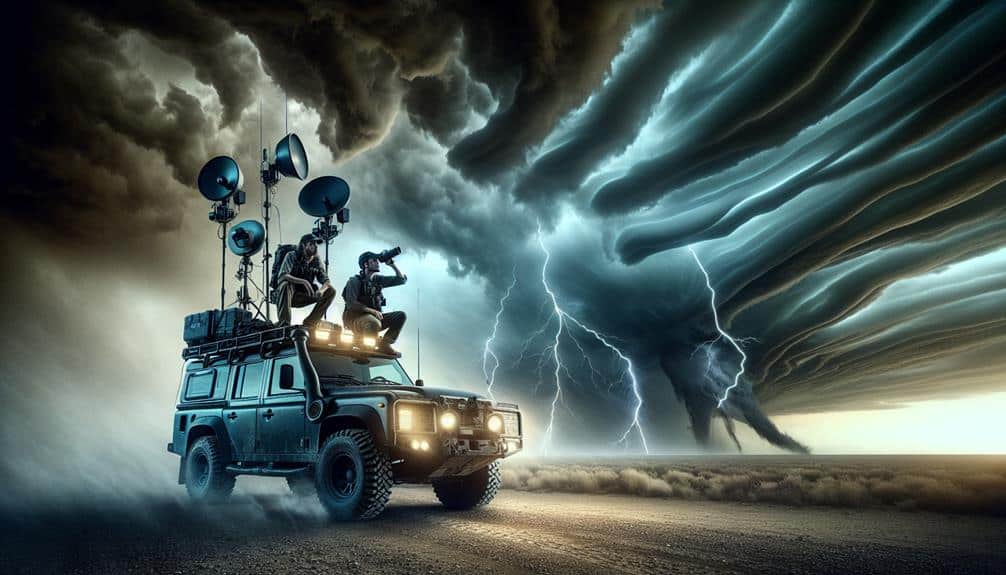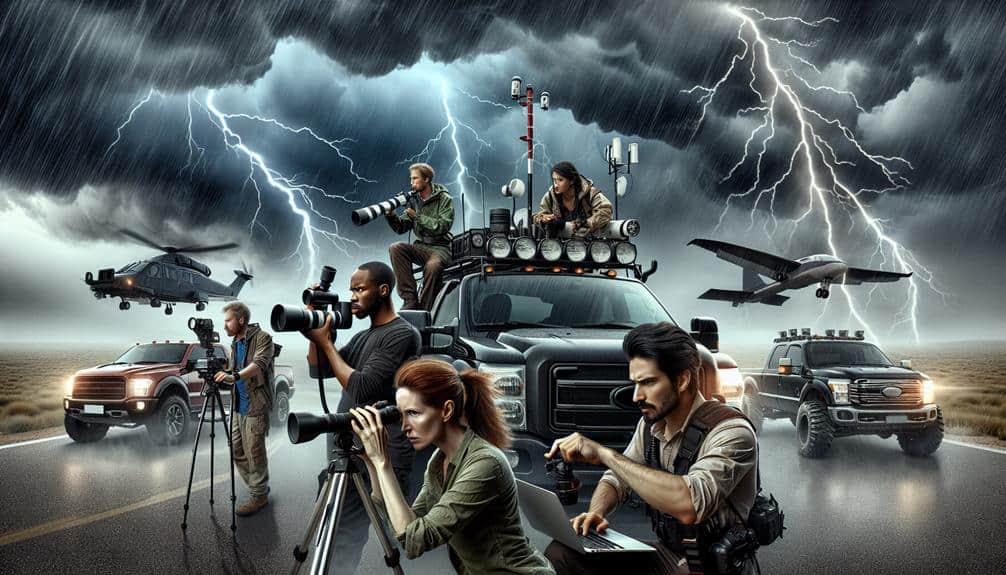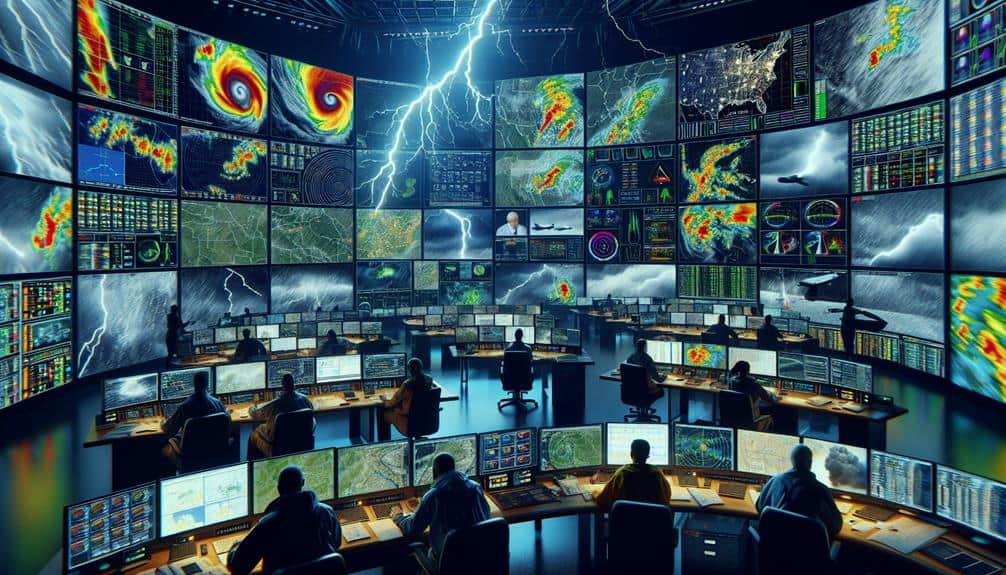We combine advanced weather technology, like radar forecasting models and drone observations, with precise communication protocols, using GPS and radio devices, to guarantee real-time updates. Safety is our top priority; we perform thorough safety drills and vehicle checks. By coordinating with local authorities, we share critical data to aid emergency responses. Integrating these elements allows us to collect and analyze accurate weather data, refining our predictive models and improving efficiency. These tactics form the backbone of effective storm chasing, and understanding them further uncovers the nuances and precision required in this field.
Key Points
- Establish clear communication procedures with local authorities to align with emergency response efforts.
- Utilize advanced weather technology, such as drones and radar, for precise storm tracking and data collection.
- Maintain constant communication using radio devices, GPS trackers, and satellite phones for real-time updates and team coordination.
- Conduct regular safety drills and vehicle inspections to ensure preparedness and minimize risks during storm chasing.
Coordinating With Local Authorities
When coordinating with local authorities, we must establish clear communication procedures to guarantee safety and efficiency during storm chasing operations. This secures our team's movements are synchronized with emergency response efforts, minimizing risks for both us and the general public.
First, we need to liaise with local emergency management agencies. By doing this, we integrate our real-time observations with their broader emergency response plans. Sharing data on storm paths, intensity, and timing allows for more accurate and timely public warnings, enhancing overall community safety.
Next, establishing robust public relations strategies is vital. We should proactively communicate our intentions and operational zones to local authorities and the public. This transparency builds trust and avoids misunderstandings that could hinder our operations. For instance, issuing press releases or coordinating with local news outlets helps keep the public informed about our presence and purpose.
Additionally, we must make sure that our equipment and vehicles are easily identifiable. This aids law enforcement and emergency responders in recognizing our team, which can expedite coordination during critical moments. By maintaining these clear communication channels and public relations efforts, we can operate more freely and effectively while contributing valuable data to emergency response initiatives.
Utilizing Advanced Weather Technology
Leveraging state-of-the-art meteorological tools and software, we can enhance our storm tracking accuracy and prediction capabilities. By integrating advanced technologies like drone observation, satellite monitoring, radar cartography, and storm forecasting models, we can stay ahead of severe weather events and make informed decisions in real-time.
Drone observation provides us with unparalleled aerial views of storm formations, allowing us to capture data from angles and altitudes that were previously inaccessible. This real-time data is essential for understanding storm development and progression.
Additionally, satellite monitoring offers a macro perspective, giving us a bird's-eye view of weather systems over large areas, facilitating better long-range planning.
Radar cartography is another indispensable tool. High-resolution radar imagery helps us pinpoint storm locations, intensity, and movement. This precision enables us to predict the storm's path more accurately and adjust our chase strategies accordingly.
- Drone observation: Offers real-time aerial data.
- Satellite monitoring: Provides macro-level weather system views.
Effective Communication Protocols
Effective communication protocols are vital for maintaining the safety and coordination of our storm chasing team during intense weather events. Our team coordination relies on strong communication strategies that facilitate real-time updates. Each member is equipped with radio communication devices and GPS trackers, allowing us to share precise locations and weather observations instantly. This setup guarantees that everyone is fully aware of the storm's movements and each team member's position relative to it.
During an emergency response, response time is crucial. As a result, predefined communication codes and protocols are established to convey urgent messages swiftly. For instance, a specific code might indicate an imminent threat, prompting immediate action without the need for lengthy explanations. This streamlined method enhances our ability to react promptly and efficiently under pressure.
Moreover, we utilize multiple communication channels, including satellite phones and mobile apps, to ensure redundancy. In areas where one system might fail due to poor signal or technical issues, alternative channels keep the information flow uninterrupted. This redundancy is essential for maintaining continuous real-time updates and making sure that no critical information is missed.
Safety Measures on the Field
Our main focus in the field is making sure every team member follows strict safety protocols to reduce the inherent risks of storm chasing. We recognize that the excitement of the chase can sometimes overshadow the importance of safety, but effective team coordination and emergency response readiness are crucial.
To ensure we're ready for any situation, we implement the following measures:
- Regular Safety Drills: We conduct frequent drills to practice emergency response scenarios, making sure every team member knows their role.
- Real-time Communication: Using advanced communication tools, we maintain constant contact to coordinate movements and share live updates on storm developments.
These protocols are crucial because they not only safeguard our lives but also improve our ability to gather valuable data safely. By prioritizing safety, we empower our team to operate with the freedom to focus on our mission without unnecessary risk.
Effective storm chasing requires not only courage but also careful planning and unwavering commitment to safety measures.
Data Collection and Analysis

Collecting precise data is the backbone of our storm chasing endeavors. We rely heavily on real time monitoring to stay ahead of rapidly changing weather conditions. Our vehicles are equipped with advanced radar systems and weather stations to capture data on temperature, humidity, wind speed, and atmospheric pressure. These measurements are essential for making split-second decisions that keep us safe and effective in the field.
Predictive modeling is another vital component of our strategy. By feeding real-time data into sophisticated algorithms, we can anticipate storm paths and intensity with remarkable accuracy. This allows us to position ourselves strategically, maximizing our chances of observing tornadoes or other severe weather phenomena. We use tools like the Weather Research and Forecasting (WRF) model to simulate potential scenarios, adjusting our plans accordingly.
Data collection doesn't end in the field. We analyze the gathered information meticulously to refine our predictive models. This iterative process improves our future forecasts, enabling us to chase more efficiently and safely.
Ultimately, our goal is to balance the thrill of the chase with the scientific rigor required to contribute valuable insights to meteorological research. By leveraging real-time monitoring and predictive modeling, we elevate our storm chasing to a professional, data-driven pursuit.
Frequently Asked Questions
How Do Storm Chasers Fund Their Expeditions?
We fund our expeditions through diverse funding sources, including grants and sponsorships. Effective financial planning and meticulous budgeting guarantee we maximize resources. These strategies offer the freedom to pursue our passion without financial constraints.
What Types of Vehicles Are Best Suited for Storm Chasing?
'Better safe than sorry—our vehicle options prioritize durability and agility. We choose SUVs or trucks, focusing on safety measures like reinforced frames. Communication tactics and equipment choices, including GPS and weather radars, are essential for effective storm chasing.'
Can Anyone Join a Storm Chasing Team?
We can't let just anyone join a storm chasing team. Team dynamics and training are essential. Safety protocols and qualifications guarantee everyone knows the risks and procedures. Experienced individuals maintain order and maximize both safety and freedom.
What Personal Gear Should Each Team Member Have?
Each member needs essential gear: a reliable radio for team communication, a weather-resistant jacket, sturdy boots, and a first aid kit. Proper gear guarantees we're prepared and can function effectively in any storm-chasing scenario.
How Do Storm Chasers Handle Long Periods of Downtime?
During long downtimes, we use entertainment options and communication strategies to stay engaged. Team bonding activities and mental health care practices guarantee we stay connected and resilient. These methods promote a supportive and adaptive environment.


